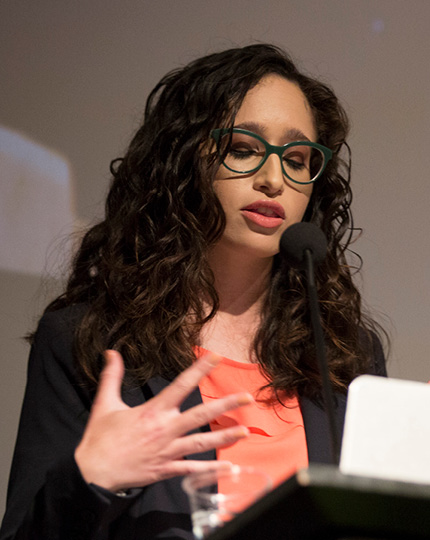
As a scholar, Professor Rachel B. Gross studies the ways American Jews, whether they go to synagogue or not, connect emotionally in their daily lives to an imagined Eastern European past — by dining in Jewish-inspired cafes, buying toys and children’s books or visiting historic places. In a book she’s writing based on her dissertation, “Objects of Affection: The Material Religion of American Jewish Nostalgia,” she’s also examining how companies and other institutions fan that nostalgia flame. Gross joined the SF State faculty a year ago as the John and Marcia Goldman Chair in American Jewish Studies.
One definition for nostalgia is “sentimental longing or wistful affection for the past.” Is that a universal sentiment or is it stronger among certain groups?
Like many humanities scholars, I’m a specialist and wouldn’t want to make generalizations. Nostalgia is definitely a cultural construct. It comes to us from the early modern Swiss period. It’s in a 1688 dissertation about Swiss mercenaries living away from home. Their nostalgia is a medical condition: They’re wasting away. Today, we think of it as an emotional condition. When I look at nostalgia, it’s thinking about the way it’s a pervasive sentiment in 20th century Jewish culture.
How have you explored this “pervasive sentiment” in your work?
I think a lot about institutions and the interplay between institutions and people’s personal experiences … about institutions creating [nostalgia] and how Jews receive it. The definition’s statement about longing is right on; it’s for the inaccessible past, a past that’s safely behind [us]. When American Jews are nostalgic, they’re nostalgic for an imaginary Central and Eastern European past and specific ethnic neighborhoods, such as New York’s Lower East Side. This emotion that comes with a storyline is something most American Jews can plug into. They can go to delis that evoke this personal American past. When I look at children’s toys and playthings, especially American Girl dolls, there’s one named Rebecca Rubin. She lives in 1914 on the Lower East Side.
How have institutions commercially tapped into this emotional, cultural thread?
I’ve been writing an article on Crisco. Crisco was marketed to Jews since it was created in 1911. Traditional Jewish dietary law, Kashrut, prohibits mixing dairy and meat. Procter & Gamble, Crisco’s creator, realized Jews were the perfect audience for its product, so [Jews] were one of the first targeted markets … Crisco put out a cookbook in 1933 for the Jewish housewife that was written in Yiddish and English and marketed to immigrant Jewish mothers and American-born daughters.
For the book you’re writing, you’ve also looked at how purchasing books and toys is one way of teaching Jewish nostalgia to children. What great children’s story exemplifies this?
I really like The Castle on Hester Street. It’s a story about a girl talking to her grandpa. Hester Street is on the Lower East Side, and the grandfather remembers this magical past when he had a flying goat. And the grandmother keeps correcting him: “It was a really difficult life, and we had too many children.” It’s about the navigation of family stories when family members’ stories are different from each other and different from what’s factual. It’s a lovely story that children respond to, yet it’s actually pretty deep.
A year into your role as the first John and Marcia Goldman Chair in American Jewish Studies for SF State, how has your vision and planning for the post evolved? How have your students’ questions and interests shaped your approach?
I’m still thinking it through. A year is not that long. One thing that strikes me is how diverse SF State is. It’s so heterogeneous; my students are all so different from each other. They bring questions to the material I do not expect.
We studied a 2008 scandal about Agriprocessors, a Kosher meat processor in Iowa. There were a number of questions about how they were treating animals and how they were treating workers. One of my students came to the material from the perspective of someone who does not eat meat and shared how he felt about the industrial food processing system. And another student’s father worked in meat processing. The 2008 scandal also had a lot to do with immigration; it was the largest federal immigration raid at the time. My students are from all different places, so to have all those issues come up with that one case study is amazing. I absolutely can’t predict what questions they’ll bring up in the future.